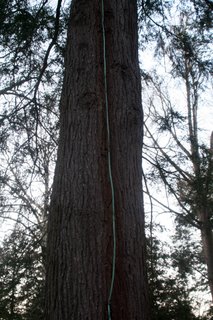 This Canada Hemlock, like all the tallest trees in Peirce's Park at Longwood Gardens, had a narrow green wire extending from somewhere in the crown of the tree beyond our sight down the full length of the trunk and into the ground. The wires were inconspicuous unless you were really looking at the trees, like my husband and I were. We wandered around enjoying the towering lindens and tulip-trees and especially the hemlocks. Some of the oldest trees here are thought to be more than 200 years old and were thoughtfully labeled for those of us who are still learning to identify them. ;-)
This Canada Hemlock, like all the tallest trees in Peirce's Park at Longwood Gardens, had a narrow green wire extending from somewhere in the crown of the tree beyond our sight down the full length of the trunk and into the ground. The wires were inconspicuous unless you were really looking at the trees, like my husband and I were. We wandered around enjoying the towering lindens and tulip-trees and especially the hemlocks. Some of the oldest trees here are thought to be more than 200 years old and were thoughtfully labeled for those of us who are still learning to identify them. ;-)We assume the trees are wired to protect them from lightning, as a strike would be life-threatening for the tree. Trees are often the tallest objects in a landscape and their deep roots and water/sap content make them a great lightning rod. From what I've read, properly protecting a tree from lightning can cost as much as $1,000 per tree and involves running copper cables down opposite sides of the trunk as well as along the main branches. These cables are then grounded well outside of the dropline of the tree to prevent root damage.
Lightning is nature's way of eliminating old or sick trees, but it would be a shame to lose such beauties as those at Longwood. This was the first time either my husband or I had seen such a thing and I wonder how common it may be. Any fellow tree-huggers know more about this?


20 comments:
Interesting, Laura. I've never seen a wired tree. It makes sense to preserve and old but still beautiful tree even though costly.
Wow, I didn't know that. That is really interesting, thanks.
From what I've seen in my travels not many trees are wired due to the expense of it - and if they are, it's just one. I've seen too many of my favorite great trees struck by lightening. My most recent siting was in Boyce Thompson Arboretum in Superior, AZ.
I tried looking at that picture, could the tree have been previously hit by lighting and they put that in after words? Never knew they did this before, would have been my first time ever seeing!
Naturewoman: I thought you might have some experience with this. We couldn't see that any of the branches were wired and there was only the wire on one side of the trunk.
An oak down the street was struck this summer - a wedge almost a wuarter of the diameter was blown out down the length of the trunk. So far the family has left it standing. I'm curious to see how long it will survive.
Monarch: The bark does look a bit strange, but I think they must have carved it out a bit in order to be able to keep the wire in place. I didn't know it was done either.
I've never seen a wired tree, either. Cool idea.
I thought you were going to say that trees have started a blog network. Imagine the tales they could tell!
the first time I saw this technique, was the first time we visited my Hb.'s family in Wisconsin. I was quite amazed. Then the other time was when we were in D.C. All the trees around the famous plantations are wired. To try to preserve them.
Tampa Bay is the Lightning capital of the world and I still have not noticed a wired tree. Maybe I will have to look a bit closer, although our palm trees out number our old growth trees here, we still have some old oaks and Banyons.
Maybe it's for internet access? :) My g/f and I are headed to Longwood Gardens/Brandywine Valley the weekend after Valentine's Day. I've been to Longwood a bunch of times and I can't wait to go back.
Trees will adapt and grow around anything that is in the way. The tree is growing around this wire - eventually it will be hidden within the tree if they don't move it.
Anyone going to Longwood should try to go to Winterthur, too! They have a great woodland setting there among many other things! I never do one without the other.
Where is my comment??? I left a comment about a) I hug trees all the time but I've never seen this and I find it fascinating, thank you very much and b) I think about our impact on species survival when I do docent activities at the Lincoln Park Zoo and feel that, overall, the tradeoffs of human intervention are a good thing. I guess I'd just as soon see us spending tax dollars on trees as the proverbial toilet seat. I think I also said I liked your bird observation reports and your succinct comments at my place. :-)
That is a first for me too. I guess preserving these big old trees requires such non-treelike interventions.
Hmmm. No clue on the wire although I think your idea of a lightening rod sounds plausible. I have seen a redwood tree (that was huge and old but planted outside its comfort zone in a hotter climate in someone's landscape) with a hose running up it's side. They actually watered it that way.
Redwoods are, as you might imagine, often hit by lightening. I'll have to photograph some trees and write a post on what that does to them. Cool . . . an assignment!
Oh yes, Laura! Toledo, (believe it or not:0) has a beautiful metroparks system.
Their logo features an ancient oak tree with immense spreading branches. It presides above a field of native grasses and twittering birds. It is very well wired. I'm sure it would have received crippling lightning strikes if not for man's intervention.
I don't think I've ever seen this before, but I agree it makes sense special, irreplaceable trees.
I don't think I've ever seen this before, but I agree it makes sense special, irreplaceable trees.
Susan: I'll have to think on that.
;-)
Silverlight: I guess maybe I don't pay enough attention.
Maggie: I think I read that somewhere about Tampa. The wires were very easy to miss.
Patrick: Oooh sounds nice! What else will you be seeing?
Naturewoman: I want to get to Winterthur one day also. A bit far for a day trip though.
Vicki: Sorry Blogger is acting up and disappeared your comment. I agree that old trees are much more valuable than government toilet seats. ;-)
Sarala: Hi. I've been poking around and found that lots of historic trees are protected this way.
Liza: I've only seen one redwood at the local botanical garden and it was little, compared to what your forest must be like. I look forward to the completion of your assignment. ;-)
Cathy: Thanks - I will have to pay more attention. I think there's an historic oak somewhere here in NJ.
FC: I'd be interested to know how much it really helps - the ones at Longwood didn't seem to be a wired up as the pro recommendations suggest they should be.
Laura,
We'll probably do all of the stuff down there in the Brandywine Valley. I've never really explored the area other than Longwood, so if you have suggestions, please let me know!
I've never seen a "wired tree" like those. But then, I don't visit that many urban forests or arboretums.
OT - Here are 2 links I meant to give you awhile ago. They are photos of decodon that I saw while doing some survey with canoe with a biologist friend. I took these photos in early autumn a few years ago. The leaves of the decodon were just partly changed to their autumn colours. Btw, I tried sending these to you in an email, but it got bounced back - that was about 3 days ago, I think.
http://magickcanoe.com/glenisle/decodon1.html
http://magickcanoe.com/glenisle/decodon2.html
Bev: Thanks for the links to your closeup pics. Wonder what's up with my email - a few people have been getting bounced messages also.
Post a Comment